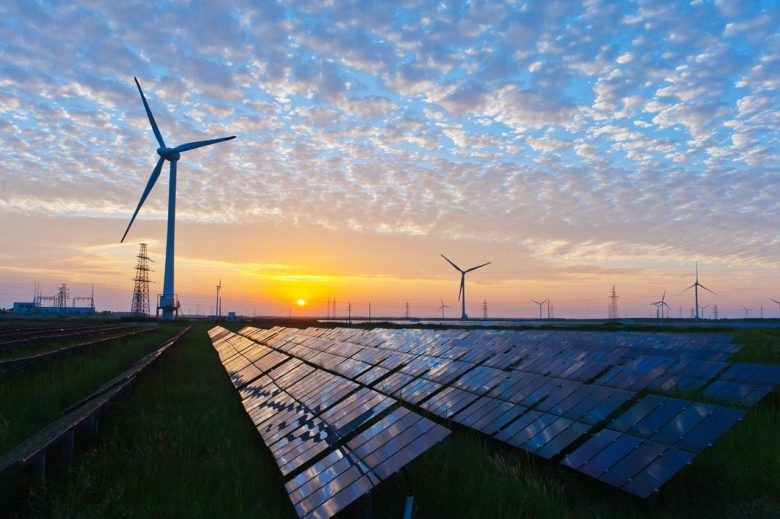
Are Wind and Solar Viable Options for 100% Renewable Energy?
We are reader-supported. When you buy through links on our site, we may earn affiliate commission.
As public concern over climate change increases, more people see the need for sustainable energy production. Traditional power generation relies on burning fossil fuels like coal and natural gas, a process which releases the warming greenhouse gas carbon dioxide into the atmosphere. Renewable energy sources like wind and solar aim to produce essential energy without the carbon emissions.
The popular demand for 100 percent renewable energy, reflected in public opinion and policy in states like California, has lead to increased investment in wind and solar power in recent years. Despite growing interest in renewable energy, it remains unclear whether renewable energy alone can get us to a zero-carbon future.
Wind and solar power represent great potential for clean, renewable electricity. However, they may not fill all the world’s energy needs by themselves. Let’s examine wind and solar as a path to 100 percent renewable energy and consider possible alternative solutions.
Can Wind and Solar Fill Energy Needs?
In 2016, combined wind and solar accounted for seven percent of the United States’ electricity generation. That’s compared to 30 percent generated by coal and 20 percent by nuclear. While the country has made strides toward using more renewable energy, wind and solar still have a long way to go.
Wind and solar power struggle to fill energy demands in part due to their uncontrollable nature. Wind turbines generate electricity when the wind is blowing and solar panels capture power only when the sun is shining. When the wind stops and the sun sets, energy production grinds to a halt. Likewise, on particularly sunny and windy days, plants flood the electrical grid with excess energy.
In order to increase stability, wind and solar plants need to store energy. Storage allows energy providers to draw on stores when supply is low and bank energy when supply exceeds demand. Though energy storage technology is likely to improve in coming years, massive grid storage increases would be necessary to accommodate 100 percent wind and solar power.
Wind and solar also struggle to compete with fossil fuels because of their efficiency. In the case of solar power, only about 20 percent of the sun’s energy actually becomes electricity. Other sources like coal have moderately higher energy conversions, though nuclear is the most efficient by far. And in comparison to wind and solar, fossil fuel plants can generate power on demand.
Though a 100 percent renewable future using only wind and solar power could feasibly occur, strategy evaluations suggest that most plans underestimate the difficulty of this process. When you consider how energy sources like solar compare to others, it becomes clear that alternative paths may be more efficient — and perhaps surprisingly, more desirable.
What Alternatives to Wind and Solar Exist?
Switching to an electrical grid totally reliant on wind and solar would require a radical revision of current power infrastructure and distribution practices. It would also require people to close existing power plants to build new ones, which would require significant push, from consumers or the government, at least in the U.S. where concern about industry often outpaces proactive environmental action.
Seeing the challenges that accompany total reliance on wind and solar, many activists and researchers promote a zero-carbon energy policy instead of a 100 percent renewable version. From their perspective, stopping climate change necessitates the use of all humanity’s energy resources.
Nuclear power offers one alternative to wind and solar. Nuclear power is highly efficient and generates electricity regardless of weather. Furthermore, nuclear power may be in some ways more environmentally friendly than solar power, for example.
Generating solar power uses lots of land, as panels must be placed where the sun can reach them. Often, developers build solar farms in places where ecosystems and biodiversity suffer. Because a nuclear power plant is more compact than a solar farm, nuclear power may be a better zero-carbon replacement for traditional fossil fuels.
Another potential alternative or supplement to wind and solar power generation would transform existing fossil fuel burning plants into cleaner versions. Carbon capture and storage (CCS) technology would allow power plants to continue operations without releasing CO2 into the atmosphere, preventing warming without shutting down functional facilities immediately.
In addition to nuclear power and CCS, hydropower and geothermal remain other good sources of clean electricity. As supplements to wind and solar, these alternatives would make a zero-carbon future easier to obtain.
Can We Reach 100 Percent Renewable Energy?
Though providing 100 percent of the world’s electricity through wind and solar may not happen as easily as many hope, we can make a zero carbon future reality. Using a variety of clean energy sources, it’s possible to phase out fossil fuels and combat climate change without turning all our backyards into wind farms.
With pressing issues like global warming and pollution knocking on the world’s door, pursuing clean energy is more important than ever. With determination, innovation and a willingness to consider all available options, we can power a cleaner future together.
Share on
Like what you read? Join other Environment.co readers!
Get the latest updates on our planet by subscribing to the Environment.co newsletter!
About the author

Jane Marsh
Starting from an early age, Jane Marsh loved all animals and became a budding environmentalist. Now, Jane works as the Editor-in-Chief of Environment.co where she covers topics related to climate policy, renewable energy, the food industry, and more.





